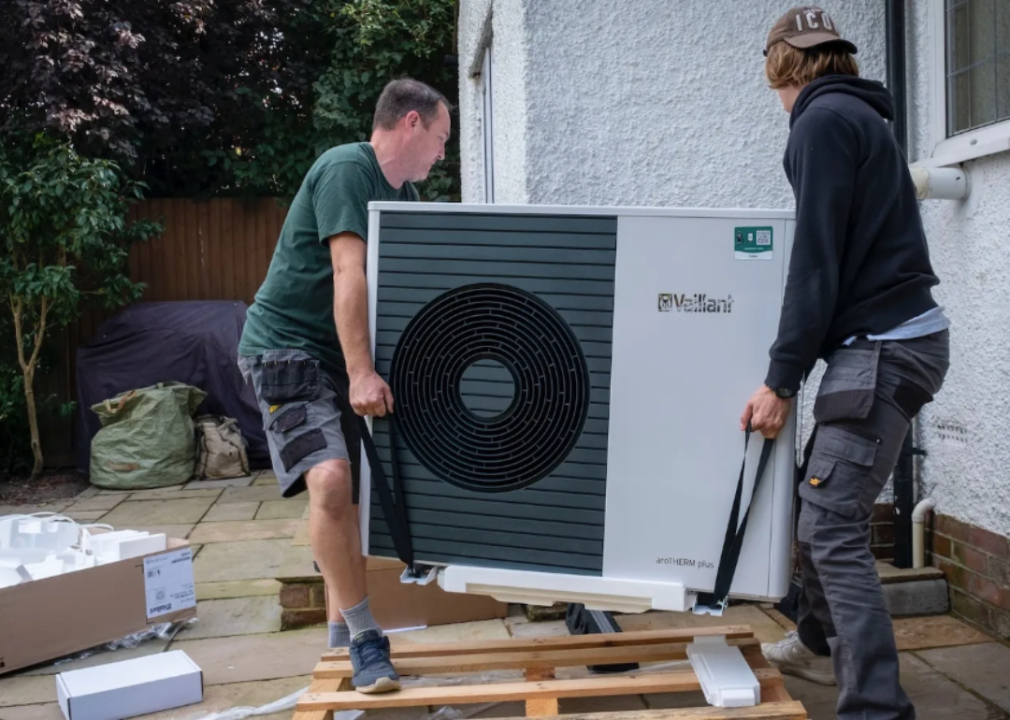Electrifying your home more efficiently is about to get a lot cheaper

Andrew Aitchison / In pictures via Getty Images via Grist
Electrifying your home more efficiently is about to get a lot cheaper
Two men installing a heat pump at a residential home
Making homes more efficient and more electric is critical to combating climate change. But the undertaking can be expensive and beyond the financial reach of many families.
Help, however, is on the way.
Residential energy use accounts for one-fifth of climate-warming greenhouse gas emissions in the United States. President Biden’s landmark climate bill, the Inflation Reduction Act, takes aim at this issue by allocating $8.8 billion to home energy efficiency rebates primarily for at low- and moderate-income households.
“For the federal government, this is the largest investment in history,” said Mark Kresowik, senior policy director at the nonprofit American Council for an Energy-Efficient Economy. “These rebates have the potential to provide tremendous support, particularly for low-income households, in terms of reducing pollution, reducing energy costs, and making homes more comfortable.”
Grist looks at how rebates from the Inflation Reduction Act could help low- and middle-income households save thousands on heat pumps, weatherstripping, and other efficiency improvements.
States will administer the rebate programs under guidance the Department of Energy released in late July. The money could become available to consumers as early as the end of this year, though the bulk is expected throughout 2024. In some cases, the incentives could cover the entire cost of a project.
Incentives will fall into two buckets, with about half designated for home electrification and the remainder going toward overall reductions in energy use. The funding will be tied to household income.
States must allocate about 40 percent of the electrification money they receive to low-income single-family households and another 10 percent toward low-income multifamily buildings. The rest of the electrification rebates must go to moderate-income households. These are minimums, said Kresowik, noting that states can, and some likely will, make even more of the rebates need-based.
Income limits are location dependent and set by the Department of Housing and Urban Development. Low income is defined as 80 percent of area’s median household income, while moderate income is up to 150 percent. What that means can vary widely. In San Francisco, for instance, the low income threshold for a family of four is $148,650, while in Bullock County, Alabama it’s $52,150.
The rebates also are larger for low-income households. On the electrification front, the guidelines call for up to $8,000 for heat pumps, $840 for induction stoves, and $4,000 to upgrade an electric panel, among other incentives. That said, no single address can receive more than $14,000 over the life of the program. The discounts are largely designed to be available when the items are purchased, which avoids having to paying out of pocket and waiting for a check from the government.
“These are advanced technologies. Therefore they often cost more, but they save more energy and help save the climate,” said Kara Saul-Rinaldi, president and CEO of the AnnDyl Policy Group, an energy and environment strategy firm. “If we want our low-income communities to invest in something that’s going to benefit everyone, like the climate, we need to provide them with additional resources.”
For the energy-reduction incentives, the type of technology used doesn’t matter as long as households lower their overall energy use. Homeowners could do this by installing more insulation, sealing windows, or upgrading to more efficient heating and cooling systems, among other options. The rebate amounts are a bit more complex to calculate but are based on either modeled or actual energy savings, and increase if you save more energy or are low income.
This story was produced by Grist and reviewed and distributed by Stacker Media.
![]()





